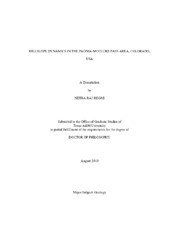| dc.contributor.advisor | Giardino, John R. | |
| dc.creator | Regmi, Netra Raj | |
| dc.date.accessioned | 2011-10-21T22:03:38Z | |
| dc.date.accessioned | 2011-10-22T07:11:38Z | |
| dc.date.available | 2011-10-21T22:03:38Z | |
| dc.date.available | 2011-10-22T07:11:38Z | |
| dc.date.created | 2010-08 | |
| dc.date.issued | 2011-10-21 | |
| dc.date.submitted | August 2010 | |
| dc.identifier.uri | https://hdl.handle.net/1969.1/ETD-TAMU-2010-08-8573 | |
| dc.description.abstract | Mass movement can be activated by earthquakes, rapid snowmelt, or intense rainstorms in conjunction with gravity. Whereas mass movement plays a major role in the evolution of a hillslope by modifying slope morphology and transporting material from the slope to the valley, it is also a potential natural hazard. Determining the morphology of the mountain slopes and the relationships of frequency and magnitude of landslides are fundamental to understanding the role of landslides in the study of landscape evolution, and hazard assessment.
Characteristics of the geomorphic zones in a periglacial landscape were evaluated by plotting local slopes and the drainage areas in Paonia-McClure Pass area of western Colorado. The study suggested that the steepness and concavity of mountain slopes and stream channels in the study area are related by an exponential equation. Seven hundred and thirty five shallow landslides (<160,000 m2) from the same study area were mapped to determine the frequency-magnitude relationships of shallow landslides and to develop an optimum model of mapping susceptibility to landslides. This study suggests that the frequency-magnitude of the landslides in Paonia-McClure Pass area are related by a double pareto equation with values α= 1.1, and β = 1.9 for the exponents. The total area of landslides is 4.8x10⁶ m² and the total volume of the landslides is 1.4x10⁷ m³. The areas (A) and the volumes (V) of landslides are related by V = 0.0254xA^1.45. The frequency-magnitude analysis shows that landslides with areas ranging in size from 1,600 m2 - 20,000 m2 are the most hazardous landslides in the study area. These landslides are the most frequent and also do a significant amount of geomorphic work.
Three quantitative approaches: weight of evidence; fuzzy logic; and logistic regression; were employed to develop models of mapping landslides in western Colorado. The weight of evidence approach predicted 78 percent of the observed landslides, the fuzzy-logic approach also predicted 78 percent of the observed landslides, and the logistic regression approach predicted 86 percent of the observed landslides. | en |
| dc.format.mimetype | application/pdf | |
| dc.language.iso | en_US | |
| dc.subject | Western Colorado | en |
| dc.subject | Hillslope dynamics | en |
| dc.subject | Landslides | en |
| dc.subject | Landslide frequency and magnitude | en |
| dc.subject | Susceptibility to landslides | en |
| dc.title | Hillslope Dynamics in the Paonia-McClure Pass Area, Colorado, USA | en |
| dc.type | Thesis | en |
| thesis.degree.department | Geology and Geophysics | en |
| thesis.degree.discipline | Geology | en |
| thesis.degree.grantor | Texas A&M University | en |
| thesis.degree.name | Doctor of Philosophy | en |
| thesis.degree.level | Doctoral | en |
| dc.contributor.committeeMember | Vitek, John D. | |
| dc.contributor.committeeMember | Mathewson, Christopher C. | |
| dc.contributor.committeeMember | Briaud, Jean-Louis | |
| dc.contributor.committeeMember | Sherman, Douglas J. | |
| dc.type.genre | thesis | en |
| dc.type.material | text | en |


